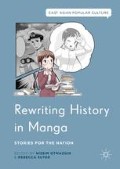Abstract
The origins of manga are intimately linked to non-sanctioned narratives of contemporary political and cultural history. Shimizu Isao has called Kanagaki Robun’s and Kawanabe Kyôsai’s Eshinbun nipponchi (1874, 絵新聞日本地 Illustrated Japan News) the “first” manga magazine (Shimizu 2006). Shimizu defines early or “first” manga as demarcated by a combination of graphic and textual elements, and distinguished by their connection to current events and politics. Manga of the Meiji period (1868–1912) thus shares an intertwined history with the development of newspapers and periodicals in late nineteenth-century Japan. Theorizing the major difference between what he terms “Edo manga” and modern manga, Shimizu claims that the defining difference arises from the use of contemporary issues as modern manga’s subject matter (Shimizu 1986:1). It is precisely its engagement with history that defines Meiji manga.
Access this chapter
Tax calculation will be finalised at checkout
Purchases are for personal use only
Notes
- 1.
Brienza cites the separate scholarship of Roland Kelts, Kaoru Misaka, and Susan Napier for this summation of the appeal of contemporary Japanese pop culture in general, and manga in particular (Brienza 2009: 103).
- 2.
- 3.
- 4.
Dajare can be thought of as frivolous word play and is defined by Indra Levy as “both a habit of spoken language and a characteristic feature of popular Edo fiction” (Levy 2006: 46).
- 5.
While the influence of Japan Punch on Robun and Kyôsai’s Eshinbun nipponchi is well documented, further scholarship is needed to explore the possible link between the Illustrated London News and Eshinbun nipponchi. From the 1850s onward, Charles Wirgman was a contributing correspondent to the Illustrated London News, and the name of this influential periodical is repurposed as Illustrated Japan News (Eshinbun nipponchi) by Robun and Kyôsai.
References
Bouissou, Jean-Marie. 2010. Manga: A historical overview. In Manga: An anthology of global and cultural perspectives, ed. Johnson-Woods Toni. New York: Continuum International Publishing Group.
Brienza, Casey. 2009. Books, not comics: Publishing fields, globalization, and Japanese manga in the United States. Publishing Research Quarterly 25(2): 101–117.
Duus, Peter. 1999a. Japan’s first manga magazine. Impressions 21: 30–41.
Duus, Peter. 1999b. The Marumaru Chinbun and the origins of the Japanese political cartoon. International Journal of Comic Art 1(1): 42–55.
Duus, Peter. 2001. Presidential address: Weapons of the weak, weapons of the strong. Journal of Asian Studies 60(4): 965-997.
Harder, Hans, and Barbara Mittler (eds.). 2013. Asian punches: A transcultural affair. Berlin: Springer.
Hasan, Mushirul. 2008. Wit and humor in colonial north India. New Delhi: Niyogi Books.
Ito, Kinko. 2008. Manga in Japanese history. In Japanese visual culture: Explorations in the world of manga and anime, ed. Mark W. MacWilliams. Armonk: M.E. Sharpe.
Jordan, Brenda G. 2003. Kawanabe Kyôsai’s theory and pedagogy: The preeminence of Shasei. In Copying the master and stealing his secrets: Talent and training in Japanese painting, ed. Brenda G. Jordan and Victoria Weston. Honolulu: University of Hawai’i Press.
Kern, Adam. 2006. Manga from the floating world: Comicbook culture and the kibyoshi of Edo Japan. Cambridge: Harvard University Press.
Kinoshita, Naoyuki. 1996. Kawanabe Kyôsai, in series Shinchô nihon bijutsu bunko 24. Tokyo: Shinchôsha.
Kinsella, Sharon. 2000. Adult manga: Culture and power in contemporary Japanese society. Honolulu: University of Hawai’i Press.
Levy, Indra. 2006. Sirens of the western shore: Westernesque women and translation in modern Japanese literature. New York: Columbia University Press.
Marran, Christine L. 2007. Poison woman: Figuring female transgression in modern Japanese culture. Minneapolis: University of Minnesota Press.
Mikhailova, Yulia. 2008. Intellectuals, cartoons, and nationalism during the Russo-Japanese war. In Japanese visual culture: Explorations in the world of manga and anime, ed. Mark W. MacWilliams. Armonk: M.E. Sharpe.
Oikawa, Shigeru. 1998. Saigo no ukiyoeshi: Kawanabe Kyōsai to hankotsu no bigaku. Tokyo: Nihon Hōsō Shuppan Kyōkai.
Okitsu, Kaname. 1993. Kanagaki Robun: bunmei kaika no gesakusha. Yokohama: Yûrindô.
Rogala, Jozef. 2004. The genius of Mr. Punch: Life in Yokohama’s foreign settlement; Charles Wirgman and the Japan punch 1862–1887. Translated into Japanese by Yamashita Hitomi. Yokohama: Yûrindô.
Scully, Richard. 2013. A comic empire: The global expansion of punch as a model publication, 1841–1936. International Journal of Comic Art 15(2): 6-35.
Shimizu, Isao (ed.). 1986. Manga zasshi hakubutsukan, vol. 1, Dandan chinbun 1. Tokyo: Kokusho Kankōkai.
Shimizu, Isao. 1991. Manga no rekishi. Tokyo: Iwanami Shoten.
Shimizu, Isao. 1997a. Bigō ga egaita Meiji no onnatachi. Tokyo: Mārusha.
Shimizu, Isao (ed.). 1997b. Kindai Nihon manga hyakusen. Tokyo: Iwanami Shoten.
Shimizu, Isao. 2001. Bigō ga mita Nihonjin: fūshiga ni egakareta Meiji. Tokyo: Kōdansha.
Shimizu, Isao. 2006. Nihonjin saisho no manga zasshi ‘Eshinbun nipponchi’. Kyoto International Manga Museum. Available from http://mmsearch.kyotomm.jp/
Strecher, Matthew C. 2004. Who’s afraid of Takahashi O-Den? “Poison Woman” stories and literary journalism in early Japan. Japanese Language and Literature 38(1): 25-55.
Tada, Katsumi (ed.). 1998. Kyōsai yōkai hyakkei. Tokyo: Kokusho Kankōkai.
Takagi, Takeo (ed.). 1974. Shinbun shôsetsu-shi: Meiji-hen. Tokyo: Kokusho Kankôkai.
Tanahashi, Masahiro. 1997. Kibyōshi no kenkyū. Tokyo: Wakakusa Shobō.
Yamaguchi, Seiichi, and Shigeru Oikawa (eds.). 2004. Kawanabe Kyōsai gigashū. Tokyo: Iwanami Shoten.
Author information
Authors and Affiliations
Editor information
Editors and Affiliations
Copyright information
© 2016 The Editor(s) (if applicable) and The Author(s)
About this chapter
Cite this chapter
Shaughnessy, O. (2016). Early Meiji Manga: The Political Cartoons of Kanagaki Robun and Kawanabe Kyôsai. In: Otmazgin, N., Suter, R. (eds) Rewriting History in Manga. East Asian Popular Culture. Palgrave Macmillan, New York. https://doi.org/10.1057/978-1-137-55143-6_3
Download citation
DOI: https://doi.org/10.1057/978-1-137-55143-6_3
Published:
Publisher Name: Palgrave Macmillan, New York
Print ISBN: 978-1-137-55478-9
Online ISBN: 978-1-137-55143-6
eBook Packages: Literature, Cultural and Media StudiesLiterature, Cultural and Media Studies (R0)

